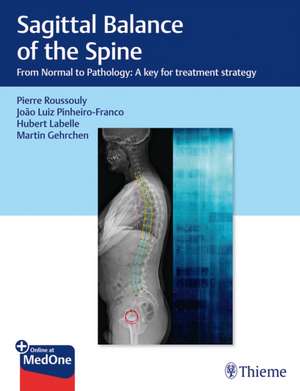Sagittal Balance of the Spine
Autor P Roussoulyen Limba Engleză Paperback – 22 oct 2019
Preț: 746.38 lei
Preț vechi: 931.32 lei
-20% Nou
Puncte Express: 1120
Preț estimativ în valută:
142.84€ • 155.10$ • 119.98£
142.84€ • 155.10$ • 119.98£
Carte indisponibilă temporar
Doresc să fiu notificat când acest titlu va fi disponibil:
Se trimite...
Preluare comenzi: 021 569.72.76
Specificații
ISBN-13: 9781626237322
ISBN-10: 1626237328
Pagini: 256
Dimensiuni: 222 x 287 x 23 mm
Greutate: 1.04 kg
Editura: MM – Thieme
ISBN-10: 1626237328
Pagini: 256
Dimensiuni: 222 x 287 x 23 mm
Greutate: 1.04 kg
Editura: MM – Thieme
Cuprins
I Introduction to Sagittal Balance
1 Historical Background of Spinal Sagittal Balance
2 The Acquisition of Human Verticality
II Biomechanics of Sagittal Balance
3 From the Head to the Feet: Anatomy of the Upright Position
4 Modeling of the Spine
5 Sagittal Balance: The Main Parameters
6 Spinal Curves Segmentation and Lumbar Lordosis Classification
III Normative Values Following Age and Populations
7 Normative Values of Sagittal Balance in Children and Adults
8 Sagittal Balance in the Elderly
IV The Sagittal Balance of the Spine in Pathology
9 Local Stresses: Segmental Mechanism of Low Back Pain and Degeneration, and Stresses According to Spinal Orientation-Contact Forces Theory
10 Mechanisms of Spinal Degeneration According to Spinopelvic Morphotypes
11 Sagittal Imbalance Compensatory Mechanisms
V The Non Scoliotic Spine
12 Isthmic Lytic Spondylolisthesis-The Physiopathology, Classification, and Treatment Better Explained by the Sagittal Balance
13 Degenerative Spondylolisthesis: Does the Sagittal Balance Matter?
14 The Degenerative Aging Spine: A Challenge for Contemporaneous Societies
15 Scheuermann's Kyphosis
16 Cervical Sagittal Alignment and Cervicarthrosis
17 Advantages and Limitations of the SRS-Schwab Classification for Adult Spinal Deformity
VI Adolescent Idiopathic Scoliosis (AIS)
18 Specificities in Growing Spine
19 Sagittal Balance Incidence on Treatment Strategy in AIS
VII Adult Scoliosis (AS)
20 From Pathological to Normal Shapes in Adult Scoliosis
21 Sagittal Balance Treatment Strategy in a Posterior Approach
22 Adult Scoliosis Treatment with an Anterior Approach
23 Techniques for Spine Osteotomies and Clinical Applications
24 Surgical Failures Mechanisms and Their Treatment
1 Historical Background of Spinal Sagittal Balance
2 The Acquisition of Human Verticality
II Biomechanics of Sagittal Balance
3 From the Head to the Feet: Anatomy of the Upright Position
4 Modeling of the Spine
5 Sagittal Balance: The Main Parameters
6 Spinal Curves Segmentation and Lumbar Lordosis Classification
III Normative Values Following Age and Populations
7 Normative Values of Sagittal Balance in Children and Adults
8 Sagittal Balance in the Elderly
IV The Sagittal Balance of the Spine in Pathology
9 Local Stresses: Segmental Mechanism of Low Back Pain and Degeneration, and Stresses According to Spinal Orientation-Contact Forces Theory
10 Mechanisms of Spinal Degeneration According to Spinopelvic Morphotypes
11 Sagittal Imbalance Compensatory Mechanisms
V The Non Scoliotic Spine
12 Isthmic Lytic Spondylolisthesis-The Physiopathology, Classification, and Treatment Better Explained by the Sagittal Balance
13 Degenerative Spondylolisthesis: Does the Sagittal Balance Matter?
14 The Degenerative Aging Spine: A Challenge for Contemporaneous Societies
15 Scheuermann's Kyphosis
16 Cervical Sagittal Alignment and Cervicarthrosis
17 Advantages and Limitations of the SRS-Schwab Classification for Adult Spinal Deformity
VI Adolescent Idiopathic Scoliosis (AIS)
18 Specificities in Growing Spine
19 Sagittal Balance Incidence on Treatment Strategy in AIS
VII Adult Scoliosis (AS)
20 From Pathological to Normal Shapes in Adult Scoliosis
21 Sagittal Balance Treatment Strategy in a Posterior Approach
22 Adult Scoliosis Treatment with an Anterior Approach
23 Techniques for Spine Osteotomies and Clinical Applications
24 Surgical Failures Mechanisms and Their Treatment
